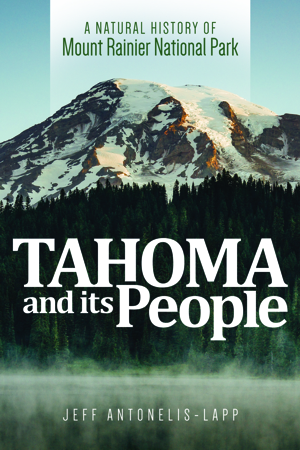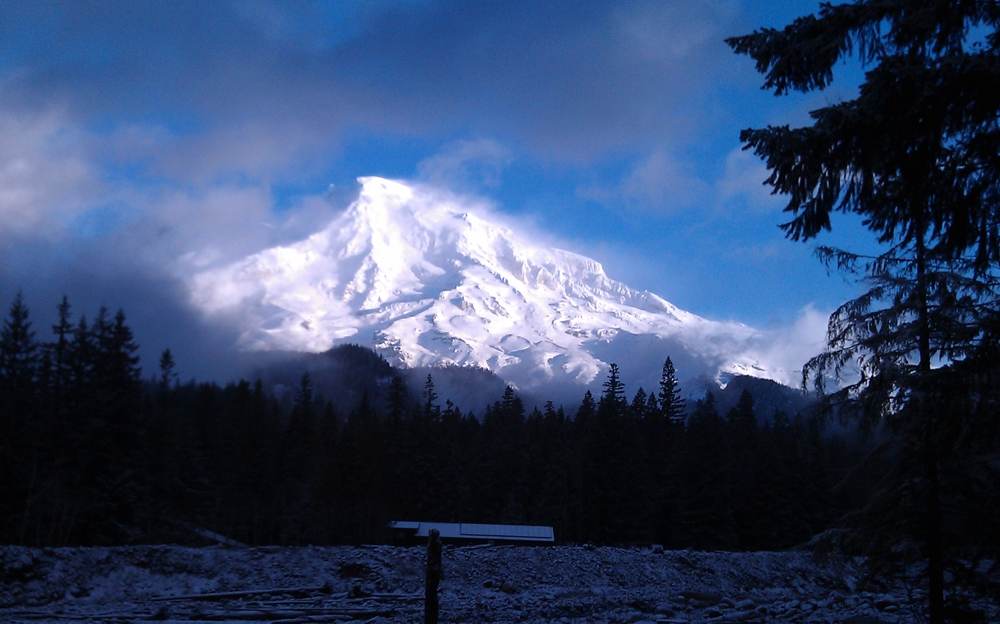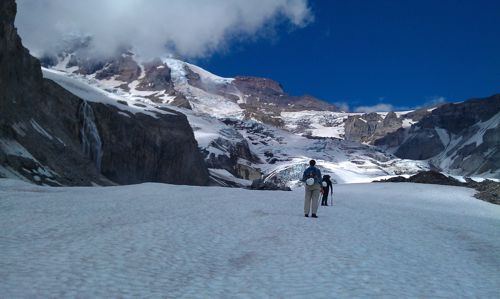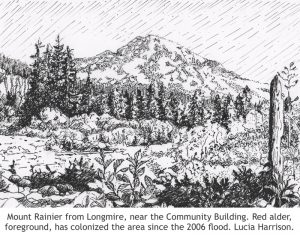What people are saying about "Tahoma and Its People" ...

“Tahoma and Its People contains so much current and unique information, that it will certainly be widely used. It is a huge legacy piece of work!”
Barbara Leigh Smith
Member of the Faculty (retired) and Native Cases Project Director
The Evergreen State College
National Park Scholar and Professor Emeritus John Miles wrote this about Tahoma and Its People:
“Science and environmental educator Jeff Antonelis-Lapp has explored, studied, and taught about Mount Rainier National Park for decades. He uses a unique approach to describing the natural history of the park, moving from personal experience to description and explanation…introduces very well the complex natural and human histories of this amazing place…a delightful selection of natural history stories—there is so much! Tahoma and Its People is an especially satisfying read.”
John Miles, Professor Emeritus of Environmental Studies, Huxley College, Western Washington University. Click here for his full review of Tahoma and Its People for National Parks Traveler.
Tahoma and Its People...
Have you enjoyed “Tahoma” in a special in a special place and would like to share a photo?
 Amazon Customer Reviews
Amazon Customer Reviews
Absolute must read book! A fantastic wonderfully written book on the natural history of Mt. Rainier
This book is wonderfully written. At first before I bought this book I was concerned the tone of the book would be dull and boring like reading a text book but I was absolutely WRONG.Read More
This book is wonderfully written in a way that it is entertaining and educational leading you gently on a delightful historical informational journey without the typical boring textbook vibe that most other books of the like give off.
The book has lots of fantastic illustrations including quite a few pictures/illustrations IN COLOR! The author uses wonderful easy to follow/understand illustrations to help break down and explain a number of different topics more specifically geological events through history of the different mountains in the area and the whole area in general making it a lot more easier for one to understand, comprehend and get a feel for the time frame of different geological events throughout this regions history relative to our human/human activity in the area time scale.
I was born and raised in Washington State living here my whole life and I’m an avid outdoorswomen and had already been quite knowledgeable and educated on this state’s natural history but I had found quite a lot of information in this book that was completely new to me and had no idea about and learned a lot of new things from this book.
I would highly recommend this book in general but I also highly recommend this book to any science/history teachers looking for a book for the whole class to read together as well.
A Wonderful Natural History of the Northwest’s Iconic Landform and State Symbol
“Live like the Mountain is out!” This phrase is heard these days to describe the lifestyle of the people of the Pacific Northwest living within the specter of the state’s iconic Mount Rainier. Read More
There is no dispute, however, about the preeminence of Mount Rainier in terms of its sheer size and mass. Rainier is the largest individual mountain in the continental United States. It is the highest peak in the Cascades at 14,410 feet and fourth tallest in the United States. Rainier is visible from most points in Washington state, and buttresses the boundary where earth meets sky. Its purple sheer walls, draped with snowy white mantels, provide a monarchical appearance. Indeed, from the south, the triune summit spurs appear like a royal crown that amplifies its sovereign grandeur.
Jeff Antonelis-Lapp has offered up a fine book that catalogs and expands on the natural history of this great mountain and eminent national Park. He organizes the book around the geology, original people, and the watersheds emanating from the peak. His geologic history of the mountain is easy to read for the lay person. He offers an important segment on the impact of climate change on Rainier and other northwest mountains and glaciers. Antonelis-Lapp reports that glacial loss and recession in the North Cascades has been substantial since 1900. The 800 glaciers in the North Cascades have lost 56 percent of their area in that time span. The glaciers of Mount Adams to the south have been reduced by nearly 50 percent in 100 years; and the glaciers in Olympic National Park “have lost one-third of their glacial ice since 1980.”
The 26 glaciers on Mount Rainier total 30 square miles, hold more ice than all other Cascade glaciers combined, and account for 25 percent of all the glacial ice in the lower forty-eight states. Mount Rainier park geologist, Scott Beason, found that perennial ice on Mount Rainier shrank by 39 percent between 1896 and 2015; and that “all of Mount Rainier’s glaciers are at their historic minimums.” Studies of the Nisqually Glacier on the mountain’s south side have determined that it has retreated 2.5 miles since 1840 and the terminus has risen from 3,800 to 5,500 feet in elevation.
The conventional wisdom among Mount Rainier archeologists before 1963 was that Native Americans did not frequent areas within today’s boundaries of Mount Rainier National Park—especially the upper reaches of the mountain. Perhaps this is because Indians like Sluiskin, who guided Hazzard Stevens and Philemon Van Trump on the first climb of Rainier, warned the climbers about the demons that dwell on the upper slopes of the peak. It was felt at that time that native people shied away from alpine and sub-alpine areas in the region’s mountain ranges because of fear and superstition. Also, by 1963 archeologists had discovered just two prehistoric sites within the park that had been occupied by human beings.
It was well established that Indians often traversed the mountain passes that crisscross the Cascades near Mount Rainier—Naches, Cowlitz, Carlton, Chinook, and White—to trade and visit family members. The Yakama Indians traveled west more than coastal Indians traveled east. But both groups possessed items of interest for their tribal brethren on the other side of the Cascade crest. Objects traded among the Native people included clams, shells, smelt, salmon, huckleberries, buckskins, baskets, and pipes. Communities of native peoples were found along the rivers and valleys that radiated from the mountain.
Antonelis-Lapp builds on Allan Smith’s Takhoma, and expands on the evidence that native peoples visited the higher realms of the mountain for generations. Just in the last fifteen years, however, archeologists and park officials have discovered new evidence—scientists have excavated over 90 sites—that prehistoric and historic peoples hunted, gathered berries, and occupied high altitude areas around Mount Rainier. They have discovered remains of food eaten by early people including wild hazelnut, elderberry, marmot, and mountain goat (Smith, Allan, 2006, xiii-xiv). It is now apparent that the original people of Washington State enjoyed the ambiance, views, as well as the bounty of the terrain in and around Mount Rainier well before the arrival of Europeans.
In his chapter on early people Antonelis-Lapp writes, “Two stalwart contributors to the park’s archeological finds, reports, and maps expanded ideas about peoples’ precontact presence on the mountain. (Dalle-Molle and Fabiani.) In addition to the individual artifacts that eventually totaled over two dozen, another rock shelter and a butchering site [in the Sunrise area] were added to the record.” He comments further on the landmark work of Burtchard and Hamilton in 1995. “This pair conducted archeological reconnaissance on more than 3,500 acres. They added an astounding 32 finds to the park’s record.”
The author provides important natural history of the major watersheds that drain Mount Rainier. He discusses the prairie-oak and river restoration of the Nisqually watershed; the first peoples, clean-up, and dangers of the Puyallup watershed; and the forest canopy and interesting life cycles of the marbled murrelet and bull trout of the Carbon watershed.
The author incorporates a narrative and map of the William O. Douglas Heritage Trail that runs 80 miles from the city of Yakima to Mount Rainier National Park (pages 197-201). Named for the Yakima native and Supreme Court justice he describes his hike along the Douglas Trail with trail pioneer, Ray Paolella, past the Pacific Crest Trail all the way to Ohanapecosh. This book is an important and fine addition to the literature on this beloved Northwest monument. The natural history details the power of this sentinel, its history, geology, ecology, and symbolism. Through our lifetime the mountain has remained unflappable and seemingly indomitable and will remain so until, based on its own timetable, it will intervene once again in geologic and human history.
Fascinating and Alarming
Tahoma and Its People: A Natural History of Mount Rainier National Park, by the author Jeff Antonelis-Lapp, is that and so much more. In his wonderful account, Antonelis-Lapp weaves a beautifully lyrical story of this wonderful landmark of America, braiding into his thousands-year tale elements of geology, botany, anthropology, zoology, and environmental science. Woven throughout the research and science, Jeff gives us numerous treats—glimpses into his firsthand experience as a life-long student of this area he so obviously loves.Read More
This book is the result of years of field studies by a trained natural scientist and educator —and a personal account of one who has harvested bark from the western red cedar with first people master weavers, participated in water environmental monitoring with pollution control teams, learned the native Wahlshootseed language, and as an avid birder was one of the few who have located the nest of the marbled murrelet. As an avid outdoorsman— one who has hiked all the mapped trails of Mount Rainier, and completed the Wonderland trail encircling the higher reaches of Mount Rainier National Park a half – dozen times–Antonis-Lapp writes with authority and passion.
Jeff is a faithful guide, taking the reader through eons of Mountain history and development—at times exhilarating, at times sorrowful. Writing as a personal field guide, science educator, story-teller, and poet, his language moves effortlessly from detailed discussions of the habitat and life cycle of lichens and American beaver, to a lyrical anecdote of an early morning observation of a family of mountain goats dancing upon upper level cliffs and marmots boxing in the lower meadows.
Jeff’s story is large in scope, long in time, and full of well-chosen detail. It is not only the story of a mountain, but how the mountain impacts the valleys below and the people living under its shadow. It is the story of the four main glaciers and how they form river valleys that empty into the Puget Sound. It is the story of the Puyallup, Nisqually, White, and Carbonado rivers, and of industrialization’s impacts on them and all that depend on them.
Tacoma and its People is a sort of “memoir of a mountain”, covering tens of thousands of years—stories past, very past, and current. But his storytelling has its purpose, pointing the reader to what unthinking use of the mountain and its resources has led to and if unabated where it will continue to lead. It is a story of what the reader can do to help preserve the beauty and wonder for all sentient beings who live in the shadow of the mountain.
Antonelis-Lapp’s lyricism makes his account both educational and delightful—a rare quality. I typically approach a scientific account with some trepidation—will it be something I will simply need to slog through, like the hike to Camp Muir, base-camp to climber’s who are intent on submitting Mount Rainier? His book is not like that at all. It is instead like a day’s journey to Panhandle gap, through lowland forest, past waterfalls, mountain meadows, tundra, and glaciers, pausing along the way to enjoy the mountain goats, black bears, marmots, chipmunks along the way.
In his introduction, Antonelis-Lapp writes;
“It seems that nearly everyone who visits, works, or lives near Mount Rainier develops a special kinship with it, a set of stories about it. This book is for them and many others. It is for those whose personal bonds span decades, for families who have created generations of memories, and those just beginning to collect them. It is for the million-plus annual visitors, some of whom travel great distances while others treat is as their own backyard, and for the native people living around it whose ancestors breathed life into the stories we continue to learn. Tahoma and its People is for anyone who loves this incomparable treasure and wishes to know it better.”
There are ample warnings in Jeff’s account of the History of this region; the wholesale pollution of the rivers born of Mount Rainier’s glaciers, the Puyallup, Nisqually, White rivers, to their termination into Commencement Bay in Tacoma and the Nisqually wetlands North of Olympia. The vanishing and endangered species through deforestation such as the northern spotted owl, who Antonelis-Lapp refers to as the “soul of the forest”, the disappearance of large areas of alpine meadows, and the reckless regard of industrialists for the lifeblood of the mountain valley-our salmon.
A particularly pleasant aspect of this account is Jeff’s animal and bird foray’s: his first hand knowledge of the American beaver, how the beavers hold their breath underwater for over fifteen minutes while the engineer their dam; How pileated wood peckers can drill into hard wood finding their daily meal; and the complicated life cycle of so many species, not least of which is the four species of salmon which Jeff describes in detail almost as a high adventure story over the course of five narrative pages. His discussion on the plight of the streaked horned lark or the marbled murrelet is with the confidence of one who has arrived to sit and wait and look in the pre-dawn hours for the object of his devotion.
Here is his first-hand account of the bull trout spawning:
“We spot a bull trout redd (a nest for fish eggs made in the gravelly riverbed). A mating pair guards it. Light spots freckle their dark bodies; a beautiful cream-colored contrast edges their pectoral fins. The female’s tail appears worn from digging the redd, the male feistily wards off a competitor. He remains nearby to defend the area for up to two weeks after spawning. The fish become sexually mature at fife to seven years of age and may breed multiple times either annually or nonconsecutively.”
Over the past twenty years, I have made precious memories while hiking many of the trails in Mount Rainier National Park. I have written about my own summit adventure (The Summit of Rainier.) But I must admit after reading Jeff’s book, I feel I have been more of an “interloper”, an aesthetic seeker, a mountain tourist.
Antonelis-Lapp addresses his hopes for this book in one of his appendices:
“The nineteenth century English biologist Thomas H. Huxley wrote, ‘To a person uninstructed in natural history, his country or seaside stroll is a walk through a gallery filled with wonderful works of art, nine-tenths of which have their faces turned to the wall’. With ample preparation, every Mount Rainier outing brings new and exciting discoveries, making its ‘wonderful works of art’ available to us all.”
The poet Mary Oliver wrote: “To pay attention, this is our endless and proper work. It is the beginning of Devotion”.
The poet G.M. Hopkins wrote; “If you look hard at anything, it will look hard at you”
Antonelis-Lapp has given us a gift—the gift of helping us to look hard at this part of our world , allowing it to look back at us with a question–what will you do now? As a result of his book, I have been given a yearning to go back and see for myself in a completely different way. I expect during my next trip to the mountain, I will watch for signs of the saga of the first people who first inhabited the mountain. I will look for the caves they once made temporary homes in while hunting and berry collecting in the fall. I will listen for their whispers as I pass by the great western red cedars and Douglas firs, reminding me to pay attention to where my feet trod—for this is where for thousands of years first people lived in harmony with the trees and ferns and beavers and Chinook salmon and all that makes up this great region.
Antonelis-Lapp concludes his masterful account with a statement of hope mixed with caution:
“If we imagine the salmon runs of the Puyallup River watershed of 200 years ago, we might see them as part of a complex, detailed mosaic symbolizing the bounty of the region….In our short time here, we have damaged and defiled the precious mosaic. It stands diminished and so do we, made less by our longing for more. Yet, hope lives here. What we know about resilience and restoration of natural systems tells us that we can reverse the trends and repair the mosaic.”
May it be so.
Tahoma - The book's Beginning

Captain George Vancouver, the British explorer, upheld an abiding western European tradition when he named the distant, snow-covered peak for Admiral Peter Rainier in 1792. The naming of landforms and other geographic features served multiple functions, and doing so in honor of others signaled a gesture of fondness, gratitude, or respect. Had Vancouver known that Admiral Rainier would never see his namesake or that the people living for millennia within sight of the volcano already called it by name, it would not have influenced his naming decision.
For Native Americans living near the mountain, most knew it as Taqó·bid or Ta-co-bet. Other popular names included linguistic variations of Tahoma or Takhoma, all thought to have been used by various tribal peoples. There is no universal agreement on a single meaning. Elders, linguists, and other students of the region’s indigenous languages place the meaning somewhere between “the source of all waters,” “white mountain,” or “snow peak.” Some experts believe that Tacoma described all snow-capped mountains. I titled the book Tahoma as a way to honor the region’s First Peoples and their ancestors who forged the original relationship between “the place and its people.”
I used the second part of the book’s title as one of its organizing principles. Chapter 1, “The Place: Geologic History and Processes,” details Mount Rainier’s geologic beginnings from over 40 million years ago up to the present. Other sections examine the effects of climate change on its glaciers and rivers. Chapter 2, “The People: Footprints from Days Past,” presents an overview of Puget Salish people and abundant evidence of their travels to Mount Rainier that began over 9,500 years ago to access resources that were unavailable in the lowlands. Using recent discoveries and accounts of my participation in three excavations, it paints the first full picture of the park’s remarkable archaeological record. Chapters 3 through 7 move clockwise around the mountain: the Nisqually River, Longmire, the Puyallup River, the Carbon River and Sunrise, in much the same way that many hike the 93-mile Wonderland Trail around it.
Excerpt from Chapter Three: The Nisqually River

Danger lurks on a glacier, even on the clearest days when climbers marvel at the sprawling Cascade spine stretching north to British Columbia and south to Oregon and beyond. Crevasses yawn with menace. Snow bridges collapse without warning. Avalanches and rockfalls trigger spontaneously. New hazards appear during extended periods of hot weather that cause climbing routes to deteriorate.
As Mount Adams and Mount Hood dazzle to the south, a few other trained volunteers and I climb onto the Nisqually Glacier to help measure ice velocity, a warning sign of glacial outburst floods. We work on the glacier’s lower section out of harm’s way, safe from crevasses and rockfall, but remain on high alert. There is movement seemingly everywhere, some of it undetectable. We ride, for example, on a river of ice that runs to over 400 feet thick in places, flowing over the ground beneath it at a rate of several inches to several feet per day. We hear water running invisibly under our feet in one spot. From another we watch a distant rockfall rumble down a lateral moraine, hurtling debris skyward. A volunteer takes a misstep and tumbles, a lacerated elbow a painful reminder to stay focused at all times. We are wary attendants in a delivery room where a wild river gathers all its forces for a sudden and violent birth. The river gushes forth from the glacier’s terminus in a roiling chocolate fury of clambering bedload, rocks banging against the newly born river’s bed. In a fit of splash and spray, the Nisqually River sees its first daylight and rushes off, hell-bent for the lowlands like a weary backpacker craving a cheeseburger.





